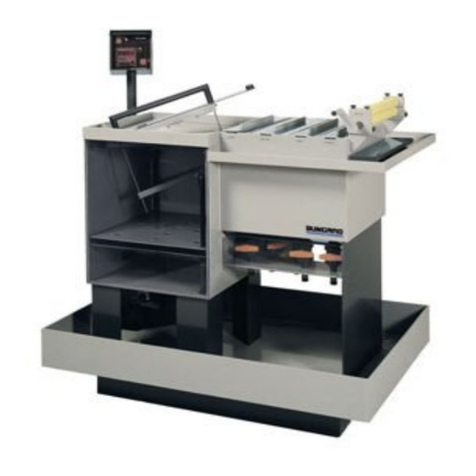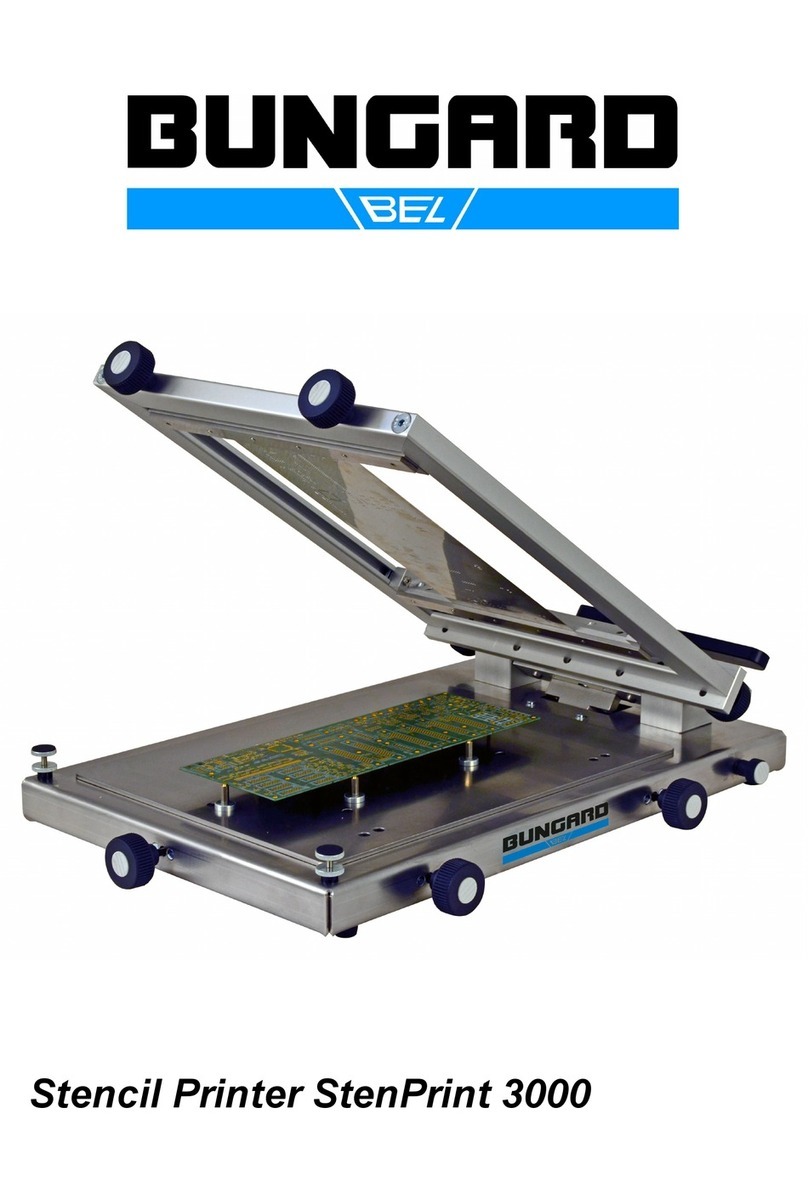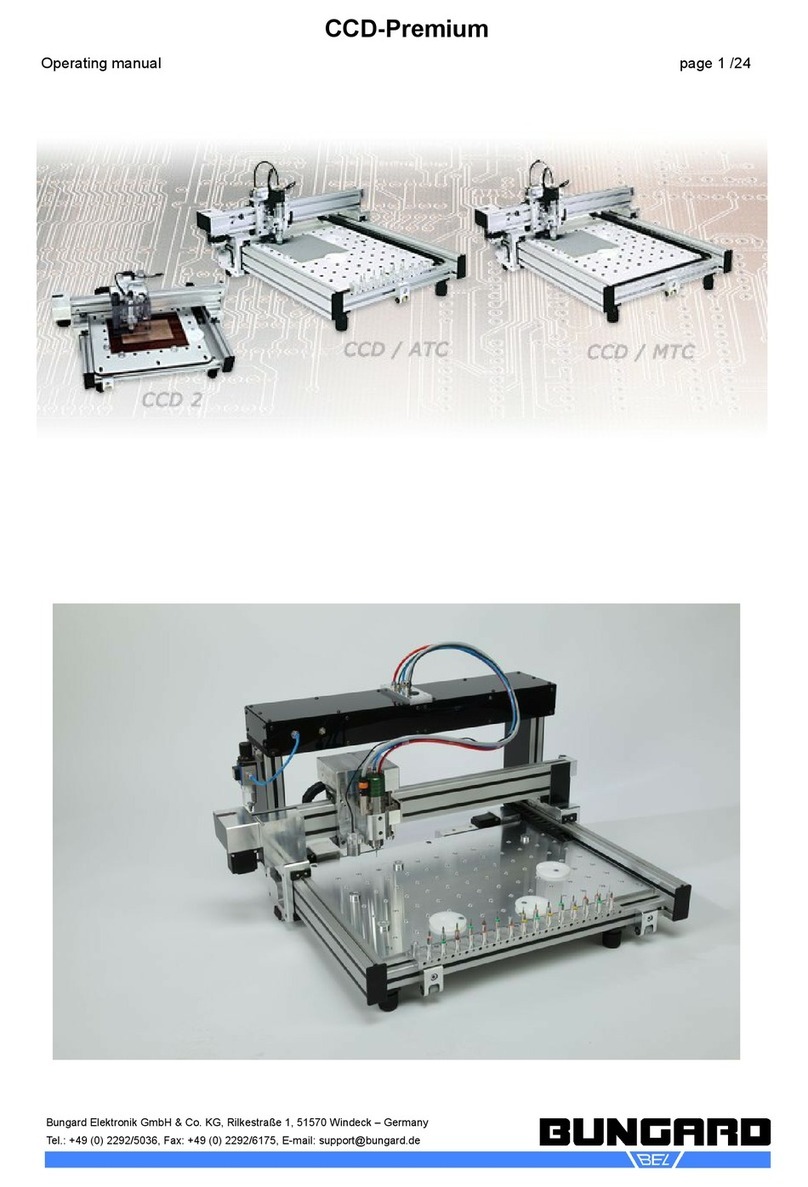
Seite 5 / 6
Keep the carrier in a slightly slanted position to al-
low e cessive liquid to drop off. Finally, rinse the
boards with the holder in the rinse compartment.
After the rinse or before feeding new boards you
put the carrier into a resting position on the edge
of the rinse compartment and on the small hori-
zontal bar inside it.
7.6 Rinse compartment
The water inlet and outlet connections are moun-
ted to the rear of the machine and can be easily
accessed through a wide opening in the machine
socket.
You may at choice use a flow or stationary rinse.
This will depend on the pollution regulations and
your in house waste water treatment facilities. If
you decide to have a stationary rinse please close
the two valves at the rinse – in and outlet. For a
flow rinse, open the outlet valve entirely and ad-
just the flow rate with the inlet valve. The water in-
let is equipped with a standard 3/4" threading like
household appliances.
If you use ferric chloride you may recycle the dirty
rinse water a) to substitute evaporation losses in
the etching compartment and b) for making up
fresh etchant.
8. Maintenance
8.1 Changing of the etching agent
The etching agent is discharged over a ball valve,
which is under the machine body (between the
two valves for the rinse). As described above,
youhave access to the etching chamber when
you remove the cover. This makes it easy to re-
move any sediments manually. If you use iron III-
chloride and consider the following proposal, you
can change the etching agent without large clean-
ing e penditure: With increasing saturation iron-
III-chloride tends to deposit surplus cuprous salts
as mud. The solution changes its colour from a
initially transparent to a milky green-brown. At this
time usually the etching time doubles in compar-
ison to the beginning. If you change the etching
agent at this time, then the mud formation can be
stopped and mud already set off will be brought
back into solution.
8.2 Cleaning of the machine in use of FeCl3:
Equipment:
Apron, eye protector, (Late ) gloves, 2 plastic
scrapers, 2 plastic sponges, 2 buckets, paper
cleaning cloths, plastic foil, container from plastic
for used etching agent
Chemicals:
Hydrochloric acid HCl technically, concentration
appro . 15%, quantity appro .: Jet: 18 l, stain re-
mover RX3
Proceed:
Cut the plastic foil in the double size of the utility
space of the machine. Put on protective clothing.
Discharge etching agents from the machine into
suitable container. Take up e isting sludges with
scraper mechanically and give it to the etching
agent. Lift the machine and set it on the foil. If you
do not have an e haust move the machine to
proper ventilated room or outside.
Fill the machine with 15%iger HCl. Close the cov-
er. Run the machine with heating switched on for
several hours. Repeat if necessary the cleaning
run the ne t day.
To Clean from the outside give warm water into a
bucket. Add stain remover on a wet sponge and
use it like abrasive powder Let the paste act on
the surface, if necessary moisten again with
sponge. Repeat this procedure, until the marks
are faded. Particularly persistent deposits care-
fully dab with HCl. To clear rinse thoroughly wipe
of machine with a not dripping sponge and clean
this sponge in a second bucket.
Discharge HCl from the machine and store to re-
use it again. Close drain valve. If the machine is
not filled again, wipe off the inside of the machine
beginning from the top and working your way
down. Clean sponge in second buck. Do not
touch the uncleaned parts of the machines, wear
long sleeved gloves. Give the contents of the
second bucket to the used up etching agent. Al-
ternatively you can rinse the machine from the in-
side by test run with water.
Jet 34d
Etching machine
Operating Instructions
Bungard Elektronik GmbH & Co. KG, Rilkestraße 1, 51570 Windeck – Germany
Tel.: +49 (0) 2292/5036, Fa : +49 (0) 2292/6175, E-mail: support@bungard.de
































